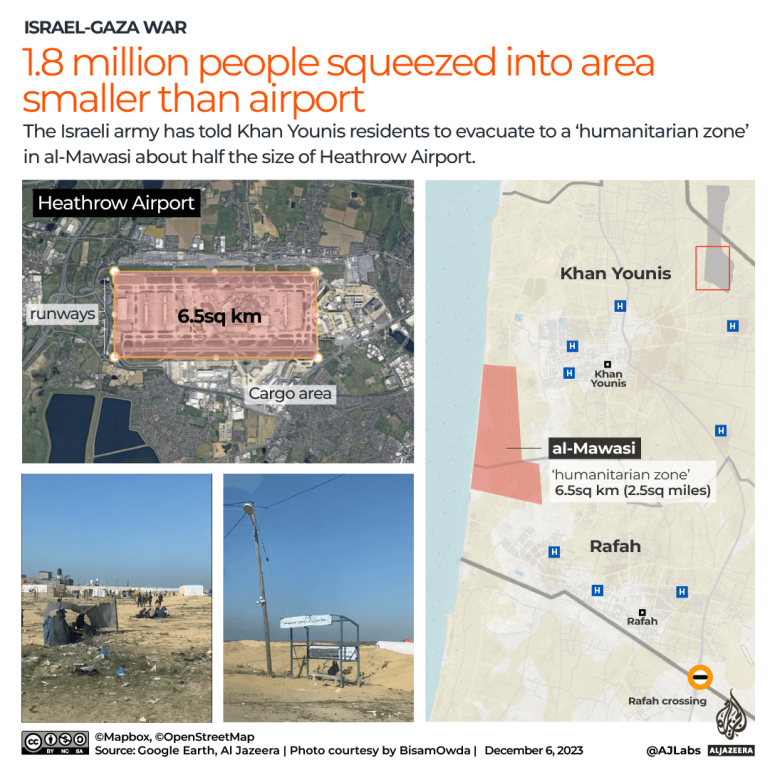al Jazeera:
How Israel is squeezing 1.8 million Palestinians into an airport-sized area
Israel has declared an area smaller than Heathrow Airport as a safe space for Gaza’s displaced people to move to.


While some Palestinians are sheltering in UN schools in Khan Younis, Israel's marked area for evacuation houses 21 shelters and 50,000 internally displaced people [Ibraheem Abu Mustafa/Reuters]
Published On 6 Dec 2023
The Israeli military has asked Palestinian residents of Gaza to evacuate to a part of the town of al-Mawasi in the south of the besieged strip, designating it as a safe space.
The directive comes at a time when Israel has stepped up its bombing of southern Gaza, especially around the city of Khan Younis, which the Israeli military claims is sheltering leaders of Hamas.
KEEP READING
But can the space declared “safe” by Israeli authorities actually accommodate the more than 1.8 million Palestinians who have been forced to evacuate their homes since the outbreak of violence on October 7?
How big is al-Mawasi?
A coastal Bedouin town in the south of the Gaza Strip, al-Mawasi is small and narrow – about 1km (0.6 miles) wide and 14km (8.7 miles) long. It had been surrounded by Israeli settlements until former Israeli Prime Minister Ariel Sharon disengaged settlements from Gaza in 2005.
Israel has declared a mere 6.5sq km (2.5sq miles) of desolate, sandy terrain, within the city to be the humanitarian area where evacuees are supposed to seek shelter.
That is an area half the size of London’s Heathrow Airport. About 61 million passengers passed through Heathrow in 2022, or about 167,000 a day on average.
In other words, the population density in the “safe” part of al-Mawasi would be more than 20 times that of Heathrow — even if all of the airport’s daily passengers were present there at the same time.

How safe is ‘safe’?
Israel’s increasing bombardment of southern Gaza after the collapse of a truce has thinned for safe zone options for Palestinians during the bloody war that has exceeded 60 days. Israel has deemed that Khan Younis, which was once rendered safe, is now a “dangerous combat zone”.
While Israel has claimed there are safe zones for civilians in Gaza, residents have said no place is safe, and experts pointed out that spaces earmarked by Israel for people to evacuate to are too small or incapable of hosting large displaced populations.
Is this hindering the flow of humanitarian aid to Gaza?
Ramallah-based legal expert Bushra Khalidi told Al Jazeera, “Gaza was already overpopulated … [now] we’re talking about 1.8 million people in an airport.”
Khalidi added that cholera and gastroenteritis are rapidly spreading due to the congested conditions. “People are not getting better because conditions are not allowing them to get better,” she said.
Israel’s increasing bombardment of southern Gaza after the collapse of a truce has thinned for safe zone options for Palestinians during the bloody war that has exceeded 60 days. Israel has deemed that Khan Younis, which was once rendered safe, is now a “dangerous combat zone”.
While Israel has claimed there are safe zones for civilians in Gaza, residents have said no place is safe, and experts pointed out that spaces earmarked by Israel for people to evacuate to are too small or incapable of hosting large displaced populations.
Is this hindering the flow of humanitarian aid to Gaza?
Ramallah-based legal expert Bushra Khalidi told Al Jazeera, “Gaza was already overpopulated … [now] we’re talking about 1.8 million people in an airport.”
Khalidi added that cholera and gastroenteritis are rapidly spreading due to the congested conditions. “People are not getting better because conditions are not allowing them to get better,” she said.
Is the establishment of improper safe zones in Gaza a health concern?
Khalidi is not the first to criticise Israel’s declaration of al-Mawasi as a safe space. World Health Organization (WHO) chief Tedros Adhanom Ghebreyesus called the Israeli proposal a recipe for disaster on November 17.
“Attempting to cram so many people into such a small area with such little infrastructure or services will significantly increase risks to health for people who are already on the brink,” he said, adding that the WHO will not participate in the establishment of any so-called “safe zone” in Gaza “without broad agreement, and unless fundamental conditions are in place to ensure safety and other essential needs are met, and a mechanism is in place to supervise its implementation”.

Courtesy: Bisan Owda/Instagram
Does al-Mawasi have adequate shelter arrangements?
A team from Sky News visited al-Mawasi to investigate the situation there. They found no shelter arrangements, such as agency tents or food kitchens. The area has already been facing a severe lack of healthcare facilities.
SOURCE: AL JAZEERA AND NEWS AGENCIES
Al Jazeera is the official mouthpiece of Hamas!
ReplyDelete